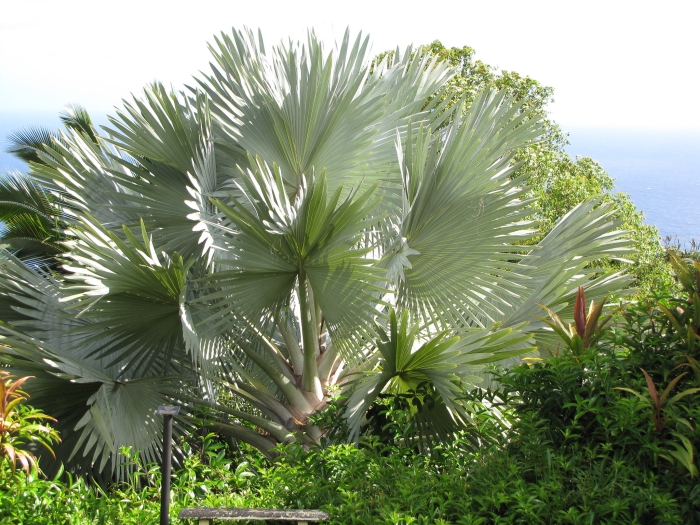Silver Bismarck Palm
(Bismarckia nobilis)
Silver Bismarck Palm (Bismarckia nobilis)
/
/

Forest and Kim Starr
CC BY 2.0
Image By:
Forest and Kim Starr
Recorded By:
Copyright:
CC BY 2.0
Copyright Notice:
Photo by: Forest and Kim Starr | License Type: CC BY 2.0 | License URL: https://creativecommons.org/publicdomain/zero/1.0/ | Uploader: Starr Environmental | Publisher: Flickr |
































Estimated Native Range
Summary
Bismarckia nobilis, commonly known as Silver Bismarck Palm, is an evergreen tree native to the open grasslands and savannas of Madagascar. This palm is particularly adapted to hot, arid environments where it can reach heights of over 25 meters in its natural habitat, though typically it grows to about 12 meters in cultivation. The solitary trunks are gray to tan with ringed indentations from old leaf bases, and the species is known for its stunning, fan-shaped, silver-blue foliage, although a less cold-hardy green leaf variety also exists. Bismarckia nobilis flowers are small and brown, with female plants producing a brown ovoid drupe containing a single seed.
The Silver Bismarck Palm is valued for its dramatic foliage and architectural presence, making it a popular choice for large gardens, parks, and as a focal point in landscapes. It is tolerant of a range of soil types, provided they are well-drained to prevent root rot. The palm is relatively easy to grow in suitable climates, requiring full sun to part shade and ample space to accommodate its wide crown. While it can withstand some drought, regular watering is beneficial for optimal growth. The silver-gray variety is more cold-tolerant, surviving brief dips to −3 °C (27 °F) and recovering from −6 °C (21 °F), whereas the green variety is damaged at 0 °C (32 °F). Potential problems include cold damage in non-tropical climates and root rot in poorly drained soils.CC BY-SA 4.0
The Silver Bismarck Palm is valued for its dramatic foliage and architectural presence, making it a popular choice for large gardens, parks, and as a focal point in landscapes. It is tolerant of a range of soil types, provided they are well-drained to prevent root rot. The palm is relatively easy to grow in suitable climates, requiring full sun to part shade and ample space to accommodate its wide crown. While it can withstand some drought, regular watering is beneficial for optimal growth. The silver-gray variety is more cold-tolerant, surviving brief dips to −3 °C (27 °F) and recovering from −6 °C (21 °F), whereas the green variety is damaged at 0 °C (32 °F). Potential problems include cold damage in non-tropical climates and root rot in poorly drained soils.CC BY-SA 4.0
Plant Description
- Plant Type: Tree
- Height: 40-70 feet
- Width: 10-15 feet
- Growth Rate: Slow
- Flower Color: N/A
- Flowering Season: Spring, Summer
- Leaf Retention: Evergreen
Growth Requirements
- Sun: Full Sun
- Water: Low, Medium
- Drainage: Medium
Common Uses
Low Maintenance
Natural Habitat
Open grasslands and savannas of Madagascar
Other Names
Common Names: Bismarckpalme, Satra, Satrabe, Satrana
Scientific Names: , Bismarckia nobilis, Medemia nobilis,
GBIF Accepted Name: Bismarckia nobilis Hildebr. & H.Wendl.